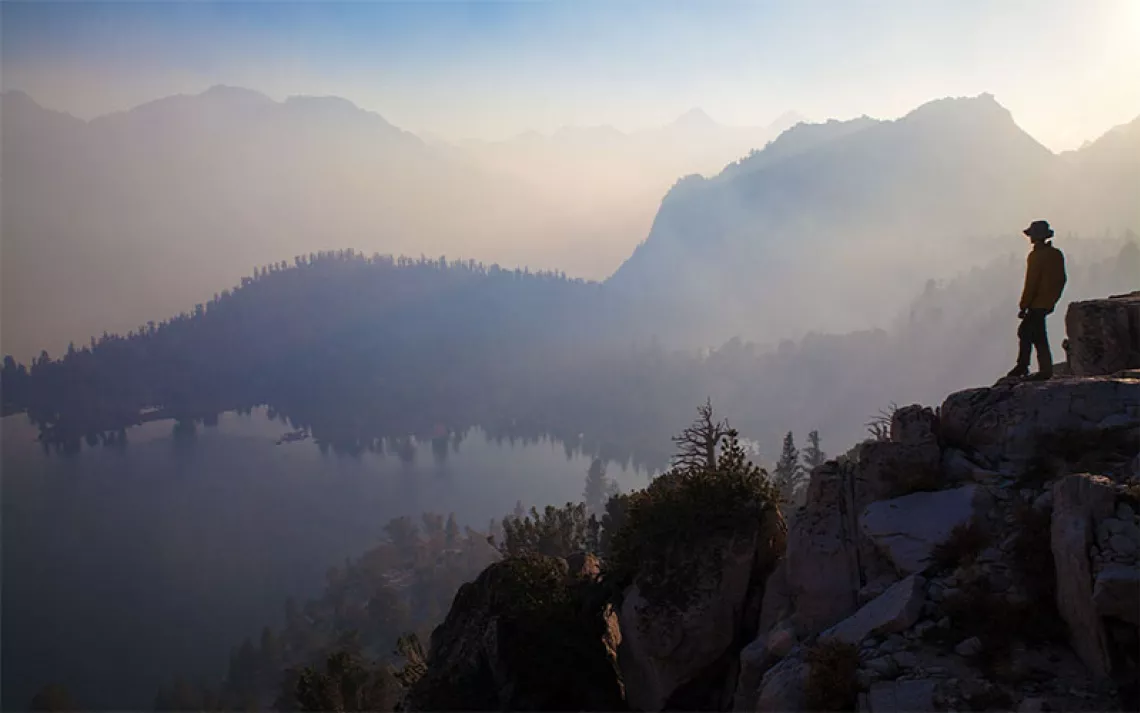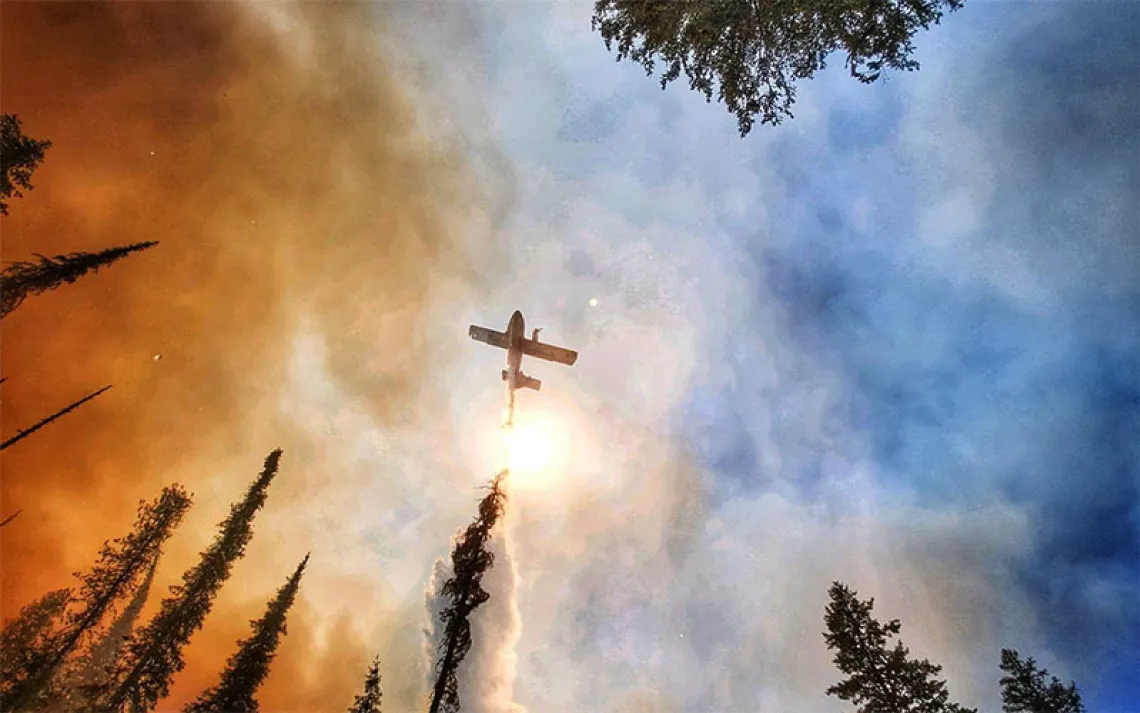The Pandemic and the National Parks
It’s anything but a typical summer in the parks

Socially distanced Yellowstone National Park visitors take in Old Faithful on June 12, 2020. | Photo by Al Knauber/iStock
A woman with a bearded dragon clinging to her shoulder poses before the ragged, snow-flecked edges of Crater Lake’s caldera and its striking blue center—the perfect Instagram backdrop. Visitors trundle between the parking lot, the Rim Village gift shop, and the lake’s edge—a summer scene not atypical for this Oregon national park.
But this isn’t anything like another summer. Crater Lake’s two visitor centers are closed, and the park has nixed its ranger programs, which includes ranger-led boat tours (the only opportunity for the public to access the namesake feature’s otherworldly blue water). Food service is available only to overnight guests of Crater Lake Lodge. Signs posted at popular overlooks encourage visitors to maintain physical distances of at least six feet and to wear a mask when that distance can’t be guaranteed.
The novel coronavirus pandemic has brought a slew of changes to America’s beloved national parks. Throughout early spring, as the country gradually shut down, the parks followed suit, either closing completely or significantly curtailing operations by shutting down visitor centers, campgrounds, and ranger programs while allowing visitors limited access to some features.
When the states began phased reopenings, the parks followed suit. Individual parks melded federal guidance with that of local and state health officials to develop their own plans. This summer, visitors will notice shifts like new porta potties to reduce visitor contact in bathrooms, virtual ranger programs, reduced campground capacity, cashless transactions and online reservations, mobile visitor centers and bookstores, and takeout-only park dining rooms.
As Americans try to shake off lockdown-induced cabin fever and stay closer to home this summer, the great outdoors is calling. And national parks top their list, though it remains to be seen whether that anticipated visitor crush—which could strain limited park infrastructure and make it hard for people to maintain physical distancing—materializes.
“While we cannot speculate on this summer’s level of visitation, we do know that visitation in recent years has remained above 300 million and that summer is typically the busiest season for many parks,” says NPS public affairs specialist Chelsea Sullivan. “As parks prepare to host more visitors, you can expect to see safety signs and floor stickers that remind visitors of the CDC’s health guidance, indicate one-way traffic flow, or visually represent six-foot distancing.”
Because cases, as of this story’s publication, are ticking up in 41 states—and skyrocketing in Arizona, Texas, and Florida—the parks are keeping their plans malleable.
“Modifications to operations will be flexible, continually evaluated, and adjusted as necessary to ensure public health and safety,” Sullivan says. This means that additional shutdowns, and a rollback of phased reopenings, are not entirely off the table for the parks.
Sally Hurlburt, the spokesperson for Shenandoah National Park, says the park is keeping an eye on case numbers. “If we have to reverse direction, we will.”
The reopening process hasn’t been without its headaches. Parks have had to stay nimble, sometimes adjusting their carefully developed plans as local conditions change in this unprecedented time. “We had to keep changing our strategy based on what the public was doing,” Hurlburt says.
She explains that Virginia’s statewide stay-at-home order, issued on March 30, made an exception for outdoor recreation, which brought “increased pressure” on Shenandoah’s most popular trails, Old Rag and White Oak Canyon. The park decided to shut those down first, to ease pressure not just on the trails, but also on surrounding county roads. Now that the trails are open again, Hurlburt says the crowds are back. She’s imploring visitors to spread out—or else.
“The park is beautiful,” she says. “There are so many other really pretty trails that are comparable to those. Try to take the pressure off of those trails, because we don't want to have to close them again, but we will if they get inundated.”
Concerns about the pandemic having an outsize impact on Native Americans—a population at particular risk due to high rates of pre-existing conditions like cancer, diabetes, cardiovascular disease, and chronic respiratory disease—have also rippled through the parks’ reopening processes.
In Montana, efforts to safeguard tribe members’ health led the Blackfeet Nation to close the reservation to traffic leading to the eastern side of Glacier National Park, including the popular Many Glacier area.
Grand Canyon National Park’s reopening has been especially controversial. The park’s eastern border abuts the hard-hit Navajo Nation, where health and income disparities have led to the highest per-capita cases of COVID-19 in the country. Visitors traveling between the canyon’s North and South Rims typically drive through Navajo land.
According to Joëlle Baird, public affairs specialist at Grand Canyon National Park, park officials communicate frequently with the Navajo Nation government, which is why last month, they chose to close Grand Canyon National Park’s east entrance at Desert View “until further notice.” The Havasupai Tribe has also closed outside access to its canyon-bottom reservation, which is beloved for its turquoise waterfalls. The national park is assisting by requesting that Grand Canyon boaters bypass Havasu Canyon. “We respect the position of the Navajo Nation and their need to safeguard tribal lands,” Baird says.
The case increase in Arizona has also led the park to pause further reopening of park facilities, including Grand Canyon Visitor Center. Park shuttle buses are not currently running, and ranger programs are canceled through summer.
At Mount Rainier National Park in Washington State, new CDC guidelines for employee housing mean the park will operate at half capacity, reducing some services throughout the summer. “We normally hire about 300 seasonal employees during the summer, who share multiperson cabins and apartments throughout the park,” says park spokesperson Kevin Bacher. “The CDC recommends that this year we limit housing to one person per bedroom, one person per bathroom. No roommates.”
Rainier’s campgrounds will operate at reduced capacity, guided hikes and campfire programs will be limited or scrapped altogether, and the park’s iconic Paradise Inn will not open. The group shelter at Camp Muir, a bunkhouse sleeping some 20 people on open platforms, may not open. (The stone shelter, constructed in 1921, provides first-come sleeping space at 10,080 feet for overnight trekkers and climbers scaling Rainier’s glacier-clad upper slopes, en route to the 14,000-foot summit.) Rainier has also changed its backcountry permitting process; the park usually splits these allotments between advanced lottery reservations and first-come, first-serve spots doled out at ranger stations. This year, the park is issuing only advanced permits to cut down on person-to-person contact. (Other marquee parks, including Yosemite, have also halted distribution of first-come, first-serve wilderness permits—so consider 2020 the year to plan ahead.)
Reopening a large, popular park like Yellowstone National Park, whose boundaries straddle three states, was an especially heavy lift. Park officials say they consulted with more than 600 business leaders, area stakeholders, and park business partners on reopening timing and other specifics. When the park unlocked its gates on May 18 after a nearly eight-week closure, visitors eager to stretch their legs flooded back in. The Guardian reported that rangers twice had to shoo away large groups of unmasked visitors at Old Faithful, the famous geyser.
Yellowstone is routinely testing employees for COVID-19, an effort that will continue throughout the summer, with priorities placed on first responders and employees interacting with the public. It’s also sampling wastewater systems at popular spots in the park; so far, the samples have not reflected the presence of the virus. Visitation remains high, though so far it isn’t eclipsing last year’s numbers.
In the event that surrounding areas—or the park itself—see a new outbreak, Yellowstone will roll back openings. “Should states and counties reinstate major health restrictions due to unacceptably high COVID-19 infection rates, the park is prepared to scale back facilities and operations as necessary,” says Morgan Warthin, a park spokesperson. “The detection of community spread in the park will also trigger the closure of facilities and potentially geographic areas.” That exact scenario unfolded last week at Texas’s Big Bend National Park, which is now closed temporarily after a park employee tested positive for COVID-19.
In advance of the summer, NPS launched an all-encompassing safety campaign called #RecreateResponsibly—combining tips for slowing the spread of COVID19, practicing Leave No Trace principles, packing the "10 essentials," and managing other risks like wildlife and wildfires. Each park is following guidelines from the Centers for Disease Control and Prevention for the cleaning and disinfection of indoor spaces, including rooms in lodges. Staff are wearing face coverings whenever they can’t maintain six feet of distance.
Though the coronavirus has only been with us for six months, there is building consensus that the virus spreads mostly through extended encounters with an infected person; brief interactions outdoors and contaminated surfaces are likely not the main vectors. With that in mind, the golden rule, park officials say, boils down to bring a mask, keep your distance, and stay home if you feel sick.
Through all this planning and detailed phased reopening guidelines, there’s a lot of uncertainty around what the next few months will look like at America’s national parks. Parks are advising visitors to be flexible, avoid popular and crowded areas, be prepared for limited food and lodging services, expect wait times at park entrances, and to make a backup plan—or two. With the ever-changing nature of the pandemic, potential visitors should keep an eye on individual parks’ websites for the latest on openings and closures. As much as Americans may be relying on the country’s wild spaces for escape and recreation, it’s anything but a typical summer in the parks.
“This summer,” Rainier’s Bacher says, “is different from any other we’ve experienced in our lifetimes.”
 The Magazine of The Sierra Club
The Magazine of The Sierra Club



